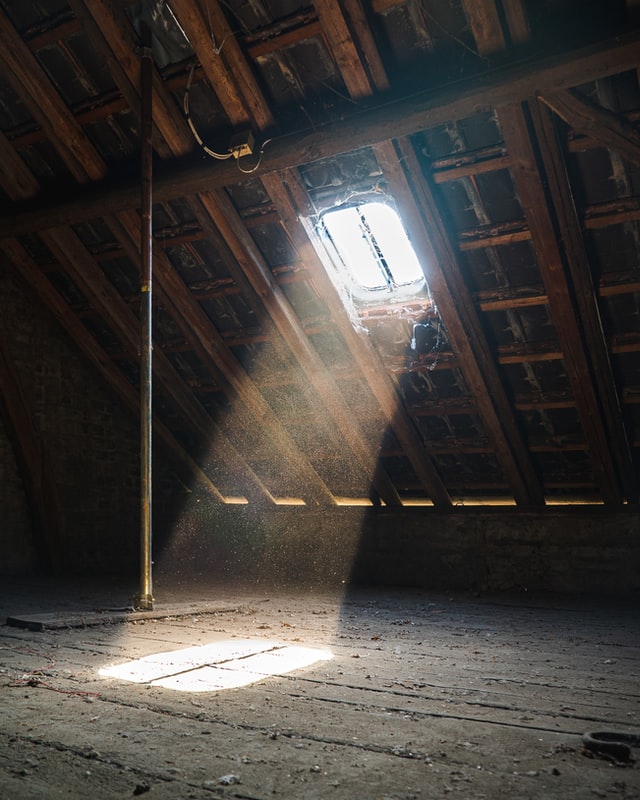Most of us think of mold as being a problem that’s limited to obviously damp environments, such as basements and bathrooms; however, in reality, mold can grow anywhere in our homes. One of the most commonly overlooked areas where mold growth tends to occur is the attic. Unfortunately, this is also one of the most insidious and harmful of all mold situations. Most people will notice mold growing on their basement walls or bathroom tiles. Therefore they catch the problem before serious structural damage to their home occurs. Because most people don’t actively use their attics, mold can flourish in this hidden-away space for months or even years before the owners even realize there’s an attic mold issue.
Why (And How) Does Mold Growth Occur In The Attic?
Contrary to popular belief, mold doesn’t actually grow within the thick layers of insulation found in most attics; it can, however, grow on the surface of this insulation. How does this occur? Usually, the mold infestation actually begins somewhere else in the attic, such as within nearby cellulose-rich structural elements (wood, paper, etc.) Mold spores then gradually drift downwards, settling on the insulation; if a food source is available, the mold can then reproduce plentifully across the insulation’s surface.
Typically, this food source arrives in the form of dust; mold can feed on the remains of dust mites quite effectively, creating something of a symbiotic food chain of allergens. All of which eventually find their way into the air of the home below.
As is the case in all areas of the home, in order for a mold infestation to begin in the attic, a source of moisture must be present. Sometimes water infiltrates via an obvious channel, such as a leak in the roofing nearby, but even if your roof is in excellent repair, it’s still possible for a mold infestation to flourish below. The culprit in these cases? Inadequate ventilation and/or a leak somewhere in the ventilation system that allows moisture from outside to enter the home (this is especially problematic in humid climates).
No matter where the attic’s moisture originates from, it quickly penetrates the cellulose materials within the attic and also becomes trapped within the fibers of the insulation itself, resulting in an overall damp environment that’s ideal for mold growth.
How Will I Know If I Have Attic Mold?
The best way to ascertain whether or not you have a moldy attic is to call in a professional inspector; he or she will be able to detect mold even if it’s not yet obvious to the naked eye by testing the sheathing, air and insulation materials.
What Should I Do If Have Attic Mold?
The first thing you must understand is the importance of acting quickly; some homeowners believe that because the attic is not (usually) an active living space like the basement or bathroom, there’s no rush when it comes to mold remediation… But this just isn’t true. Not only do mold spores from the attic inevitably circulate throughout the house, putting your family at risk of serious health problems (in addition to causing allergic reactions, mold has been implicated in cases of severe respiratory distress, pneumonia, chronic headaches, immune system disturbances, confusion, and fatigue[1]), mold can also cause serious structural damage to your home. The longer you leave an active mold infestation in place, the more costly the eventual repairs will be.
If you catch a mold infestation in its early stages, when it’s simply a thin layer resting on top of the insulation, you may be able to have the insulation professionally inspected and cleaned. You’ll then need to work with your chosen mold expert to identify the source of the moisture in your attic in order to prevent the infestation from reoccurring. If, on the other hand, the mold growth is already extensive, you will need to have the insulation removed and completely replaced.
Choosing The Right Mold Remediation Team
Before you have your attic mold removed, it’s vital that you discuss the removal process with your chosen remediation professional to ensure that it’s done correctly in accordance with you inspection protocol. Verify that they will not transport moldy insulation materials out of your house via the living areas—mold should be removed directly from the attic area to mitigate contamination risks (likewise, new insulation should not be brought in through the living areas).
Additionally, make sure that you will be working with a certified indoor air specialist or builder when coordinating the installation of your new insulation; if you fail to do so, your mold problem will simply return as moisture seeps back into your attic space. Your roof should be checked for leaks and your home’s ventilation system should be thoroughly inspected, then your chosen indoor air professional should install appropriate ventilation in your attic (through the use of ridge and soffit vents). Once the aforementioned steps have been taken, your attic should remain balanced and free from the conditions to support progressed mold.
[1] Mold Can Be Deadly, http://articles.mercola.com/sites/articles/archive/2011/09/10/fungus-hiding-in-your-house-and-making-you-ill.aspx






